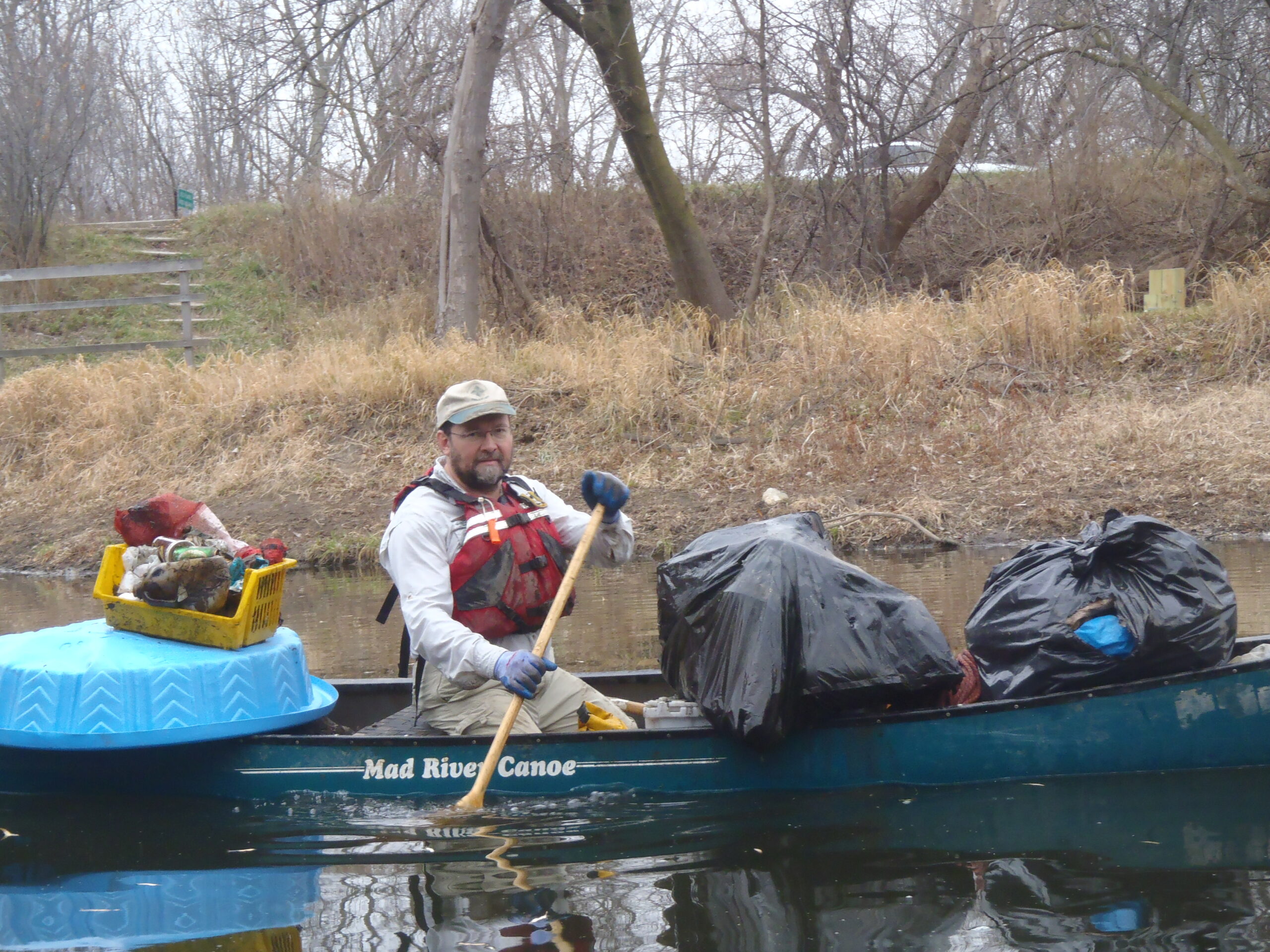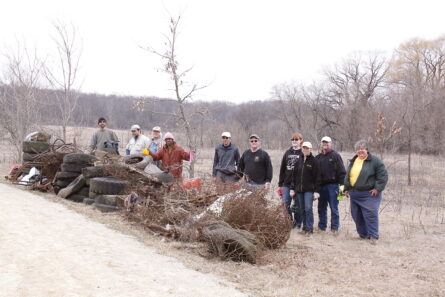News & Updates
The Des Plaines River’s Journey Back: Paul Klonowski’s Story


From over 6,000 pounds of trash pulled out of the water ten years ago to less than 450 last year. From warning signs of “Do Not Contact the River” to a haven for wildlife and paddlers alike. The clean-up of the Des Plaines River, headed up by longtime Leave No Trace member Paul Klonowski, is nothing short of remarkable.
There’s no large-scale fundraising campaign or major investments made in this story of the Des Plaines River’s clean-up. Rather, it is a story of time and effort, spanning decades, by a community of outdoors enthusiasts and land managers.
It is no small feat, and, while the fight to preserve our outdoors is everywhere, we must celebrate achievements like this. To me, this is a real life version of a common fable shared in any kind of aid work. You’ll have heard a rendition of this story before, most likely.
In it, a young man is walking on the shoreline right as dawn is breaking. Ahead of him walks an older woman, also walking. The old woman pauses, bends down, and throws something into the sea. This behavior continues, the old woman pausing and bending while, slowly, the young man catches up.
They meet, and the young man sees what’s happening. There’s hundreds of starfish washed up on the beach, and the old woman is throwing them back one by one.
“Old woman, why are you wasting so much energy on this?”
The old woman explains that, with the sun rising, these starfish will dry out and die if they’re not put back in the ocean. This has little effect on the young man.
“There’s millions of starfish on thousands of beaches, and you must be hurting your back! How does this make any difference?”
The old woman holds out the starfish she’s just picked up, holding it out to the young man.
“It makes a difference to this one.”
It makes a difference. And this isn’t one starfish, this is dozens of miles of crucial riparian habitat being returned to its natural state. I was delighted to hear Paul’s decades-spanning story and am delighted to share it with you. Walk on the beach with us.
M: It feels important to set the stage by having you share about your background outside of our river clean-up discussion today.
Paul: Well, I’m retired as of just under two years ago. I, in the nutshell version, engineered robotic assemblies for medical devices – developing hardware, writing software, doing all kinds of things in a catch-all position.
M: Tech! It’s interesting to see the juxtaposition of an extremely technical career when your personal life revolves so strongly around nature. Could you explain that?
Paul: My motivating factors started as a kid, at 9 or 10 years old. My dad was taking me on canoe trips near our Northern Illinois home, as well as down to the Ozarks.
Then, through a series of connections as a teen, I joined with a group of people who were on a canoe trip from Long Island all the way to the Bering Strait. I spent the better part of 4 paddling seasons with them.
It was an amazing experience. At the time, I lived near the confluence of the Des Plaines River and Salt Creek, its major tributary in the Western suburbs of Chicago. I remember, in junior high and high school, seeing signs of “do not contact the river.” People’s septic fields were draining directly into the rivers – you could find toilet paper there and, ah, other floaters.
Then, going on these canoe trips up north in Canada, we drank literally out of the lakes and no one ever got sick. That’s a big juxtaposition right there at a very formative age. I was 16 when I joined them in Northern Ontario and 19 when we reached Northern Saskatchewan.
M: Okay, so on one hand you have your career in technology, on the other hand you’re out canoeing often. What precipitated your foundation of this Des Plaines River clean-up group?
Paul: The root of it was in 2001, when I was canoeing down the Des Plaines River in Lake County, just north of where I grew up. I was in my solo canoe when I was overtaken by a larger group of paddlers coming downriver.
We were talking and paddling together, just playing around in the riffles. I can’t even remember if we were picking up trash, but, at the end of the trip, one of the people came up to me. I knew they worked for the Forest Preserve District, and they told me “we need you in our paddle sport programs.”
So I volunteered. The work involved teaching canoeing and kayaking, and taking the general public out on the river, an adventure program basically. We noticed the river looked pretty trashy and there were spots where we needed to clean out log jams. So we started doing that, and then, in 2008, someone decided this work needed to be its own group, separate from paddle supports.

This became the Des Plaines River Stewardship Volunteers. We were our own little group, but got a lot of support from the Forest Preserve District, who provided us with tools and equipment and a garage to store things. We’ve even had seven canoes donated to the program over the years. They may not be the nicest canoes on the market, but, man, they can take abuse – and that’s important with this work.
So that’s how we got going.
M: One thing you had mentioned when we first chatted was about the steep decline in the amount of things you’re needing to pick out of the river. What are your thoughts on how that came about?
Paul: Well, when we started doing this, we were recruiting actively from the paddling communities. We still have people with us today from that 2008 start.
We’d come out of the river after a workday with the canoes utterly loaded with junk – futons, water heaters, big stuff. There might be one person in a tandem canoe and the trash would be so high that you wouldn’t be able to see over the top.
Those days are long gone.
We had only two days this year where we found large items. Now we find one piece on this trip and one piece on that trip. We’re not coming out with canoe-loads of junk. And not only the big stuff, but also the small – plastic bags, fishermen’s tackle, beverage containers. They just don’t litter the whole river anymore.

The visible impact of not seeing all that junk is tremendous. People have commented on how wonderful it looks on social media and on the river. And there’s river otters moving back in over the past few years, as well as an increase in beavers and muskrats. So that is gratifying for me.
M: I love hearing that. Would you mind sharing the extent of your work – as in, how many miles does your team work on?
Paul: The entire river, from the Wisconsin state line to the Cook County line is about 33.5 miles. We’ve got 71 folks on our volunteer team now, with some of them, like me, are out all-year round paddling different sections of the river.
So we have people scouting the full-length of the river in the county all year round. If there’s large trash or a new log jam, it gets reported up to me and goes on the schedule.
M: In the vein of tying this back to community-first stewardship, I was curious if you had any words of wisdom for folks that want to be a part of something like this. What should be their first step?
Paul: Volunteering with an established organization is always a good first step. If you then want to branch out and do what you were already doing and something new – well, it’s pretty hard for them to say no.
“We’ve got a volunteer who wants to do this? Let ‘em go.”
If there isn’t one overriding district or organization, you can start organizing yourself. Put it up in your local newspaper, on your community social media channels, all things like that.
I now have a clean river I can float down. We pulled out 6,000 pounds of trash one year and, even with more volunteers, we didn’t even clear 450 pounds in 2022.
M: Over a tenfold decrease, wow. I’m sure folks would love to hear some of your anecdotes about what you and your team have pulled out.
Paul: [laughs] There’s been so many odd things over the years. One time we found a post-World War II vehicle with an engine like a lawnmower. Another time it was a 1948 Chevy. Oh, one time a volunteer found a houseplant she took home – it is still thriving.

A gratifying day I remember vividly came in 2013. We pulled out 41 tires, and a huge pile of other debris. It took a three-axle dump truck to haul it out. It was an old farmer’s dump site and, once we cleared that out, we stopped finding tires further down the river – we found the progenitor site.
M: I know you’ve been a member of Leave No Trace for about fifteen years – is that directly rooted from your work with the Forest Preserve District?
Paul: I became a Leave No Trace member independently of the Forest Preserve work. But the goals obviously align. I’ve been following them, oh, for decades.
I pick up after people. I don’t build rock cairns to let people know I was there. Leave No Trace is a lifestyle, and it is one I’ve been living for decades.

Oh! Another story – once we came upon a pile of tree parts, one of those areas where trash collects. There was something in the bank, I couldn’t tell what it was so I reached down and pulled it out. It was heavy, and, looking down, I saw a tiger face staring at me! It was quite the scare – a three-foot long stuffed animal. So, you know, respect wildlife. Even fake ones.
M: Thanks so much for your time today, Paul. Before we go, I like to ask this – if you only had one sentence to share out with folks, what would that sentence be?
Paul: Organize a clean-up group and go do it. I could talk about it for hours, but, boiling it down to just one sentence, I’ll go with that.
Let’s protect and enjoy our natural world together
Get the latest in Leave No Trace eNews in your inbox so you can stay informed and involved.
